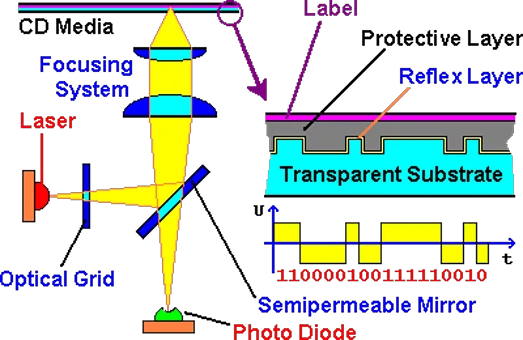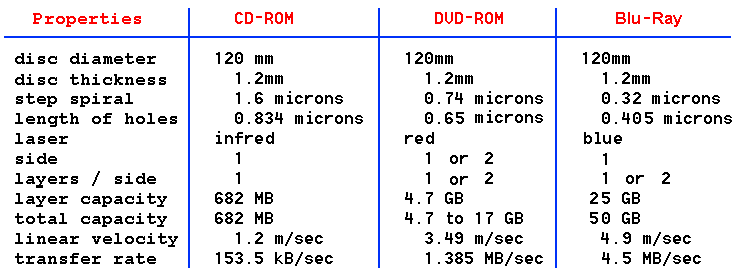Optical devices and Drives |
CD (Compact Disc) optical drives have a different way of scheduling data. Data is not stored in concentric circles, but the spiral develops from the middle to the outside. It was initially designed as a storage media devices to play music CD-DA (CD - Digital Audio). Hence the spiral path to ensure the continuity of a trace or a music track. Besides reading speed mark must always be the same, which means that the disk rotation speed increases from the center to the outside, the 200 rpm - 2120 rpm.
But very soon it was realized that the CD is very acceptable in the computing world, and the spiral is divided into sectors, which added additional control bytes stricter criteria regarding the correction of errors makes 2048 byte/sector - CD-ROM system. In this paper, the data are permitted and higher speed media, and depending on the capabilities of the device and the type of media labeled type 24x, 48x or 52x, which is associated with higher levels of speed and speed can not exceed 5000 rpm. This means lead to cracking and damage to the media device, and is recommended to be used at lower operating speeds, especially if we want to ensure quality 'recording'.
Music and videos require standardized rotational speed of the media. However, the computer applies: the faster the better, and has developed systems that can be read by the computer records repeatedly rotate faster than the speed of reading music notation.

|
|
| Figure* 3.3.19 The principle of a CD/DVD player / media. ( + / - ) |
Contents of the CD-ROM is in the table TOC (Table Of Contents), which is found in the early writings in which the data on the initial content of individual sectors. As there is no fixed split into sectors and tracks, the CD would have to move along the spiral to the optical mechanism set to the desired location. But that way would be too slow and electronics assess where he would be required sector with respect to the current position and make the obvious leap and found a new sector, and according to the method rebounds and reduce errors optics set to the desired location. As for this, and requires constant changing speed CD players are slower in accessing data from magnetic hard disks for a few dozen times. To speed up the transfer of data from the device to the computer bus optical device possess buffer (cache) SRAM type, using similar principles as reading the data on hard disk. Buffering capacity is usually the order of several MB.
The advantage of optical devices in relation to the hard drive is that you can store about 650 MB - 50 GB of data in the form of a variety of records to removable media, music, video and software, which makes it virtually irreplaceable in multimedia. CD-ROM has the lowest density of tracks and in essence is 'introduced' optical devices in computer systems. Devices with higher density recording and changing the focus optics are read by two layers of data each way to reach a capacity of over 10 GB of data (DVD-ROM). The basic purpose of their support for multimedia systems (Digital Video / Versatile Disc) seeking large amounts of diverse data. Which introduces the latest Blu-Ray technology is named after the color of the light beam used.
Example VIII
Characteristics of CD, DVD and Blu-Ray technology.

|
| Table**** 3.3.20 The basic parameters of CD, DVD and Blu-Ray system. ( + / - ) |
For DVD-ROM version is also provided with 80 mm diameter capacity of 1.4 GB - 5.3 GB with the same characteristics but write shorter length spiral. In addition to this the possibility that DVD players can recognize CD drives successfully contributes to their acceptance in the marketplace. Blu-Ray devices significantly higher capacity per media with basic label BD (Blu-Ray Disc), although the company unveiled the Sony standard, as a member of the Blu-Ray Disc Association (BDA) in 2002. year, it seems that the future of these devices do not doubt because Sony reached some agreements regarding the rights of this technology. The advantage of this technology is the existence of two layers with the same side of the substrate, which is read by changing the focal length of the laser. This technology allows the media with more than two layers, which significantly contributes to the overall capacity of the media. Cause of the development of this technology is a growing influence of HDTV (High Definition Television - 1920x1080 pixels) devices on the market, and hence the need for a medium that is able to store large amounts of data, particularly with regard to high quality video over the same length of video records lower quality on the DVD system, which was a basic requirement in the design of Blu-Ray technology.
In Figure 3.3.20b shows the relationship diameter laser beam at different optical systems for the registration of certain 'points', which is when you enter the medium optical system narrows. Power laser beam with which to write data to the media 'R' type (write once) with CD and DVD player is a few tens of mW, while the Blu-Ray unit is about 5 mW, precisely because of the fact that the point of entering physically smaller. What is the speed of rotation of the media is smaller, longer lasting write 'point', which means that when shooting events should use the lower speed record for quality records.
Due to the differences in the thickness of the protective layers between the BD, DVD and CD media and different wavelengths of laser, CDs and DVDs can not be played back in gear play only BD media. As the DVD offered compatibility with CD format, so the claim is that all Blu-Ray Players can play or record on DVDs and CDs and has developed a hybrid laser diode and an optical lens system compatible with the three wavelengths. Red and infrared lasers are mounted incorporated into the blue laser which has a high thermal conductivity, and also serves as a heat sink for the first two lasers. The predicted three basic versions of Media: BD (BD-ROM) read only 'imprinted' data, BD-R write-once and BD-RE for multiple data logging and minor version of the video format and data. It is designed and Mini Blu-Ray Disc (Mini-BD) diameter 80 mm, with 7.5 GB per layer.
Systems CD-R (CD - Recordable), DVD-R and BD-R are a special group of devices that use the disks on which was engraved preformatted groove which serves as an optical guiding mechanism. Lasers for these devices is stronger to allow heating of the substrate on which the expansion due to heat created depressions in the layer of the sensing applied to the surface similar to a CD-ROM. When the contents of one enroll and register their location in the header of a CD, the disc is still usable only as a medium for reading. Not acceptable as a medium for mass distribution, but rather as a permanent archive of quality and variety of the necessary data to the user.
Basic data write modes are CAV (Constant Angular Velocity) and CLV (Constant Linear Velocity), according to Figure 3.3.20c. CAV is similar to recording technique used on floppy disk drivers. In general this technique are proposed to store data. CLV technique maintain a constant track velocity as the diameter of the track changes. In general it is recommended for recording audio and video content. DVD burning media are produced according to two standards, DVD-R and newer DVD+R. At DVD+R media can be recorded in both formats, and DVD-R in CLV format only.
Electronics CD and DVD player designs with ATAPI IDE controller as a subset of the standard or as a SCSI device. Introducing a standard SATA optical devices with this interface are increasingly prevalent and PATA interface definitely going to 'retire'. BD devices typically are designed with SATA interface. It should be noted that there are multiple media for entering data and marked as CD-RW, DVD-RW and BD-RW, allowing about 1'000 rewrites media. The advanced technology of this type is DVD-RAM, which allows approximately 100'000 rewrites per item.
The high density of data and hence a large capacity and long lasting durability data and multimedia applicability of the main arguments use CD, DVD and BD in computer systems. But all is not idyllic. Media that are not printed (mechanical core), already used to once or multiple entry based on the principle of heating the substrate and blistering who perform hollows, are susceptible to heat (such as sunlight) and eventually losing record. Despite all the positive attributes and are susceptible to excessive scratched the surface. They should be kept in a cupboard and not leave strewn across the table. So, 100% reliable medium for storing data does not exist.
Never say - never! The new digital storage medium is M-DISC, designed to preserve and protect data by cutting into a 'rock-solid' inorganic layer, resistant to light, temperature and humidity. The industry standard tests of ISO / IEC 10995 conducted by Millenniata show that the life expectancy of M-DISC DVDs is 1332 years, with only 5% of discs showing signs of data loss after 667 years. Therefore, the projected life expectancy is several hundred years. This means that regardless of whether you save valuable photos, music libraries, medical records, or anything else, you can worry about knowing that the disc is designed to last a lifetime. The reason for this was the use of new materials (Figure 2d), and the media format remained almost the same. The new media was primarily used with DVD and BR standards, and is not significantly more expensive than the current ones. A comparison of the average data retention time is shown in Figure 2e. Optical media becomes interesting again as an integral part of the server, as a medium for backing up of data. If the polycarbonate layer of M-Disk media does not have greater 'scratch' resistance than its predecessor then this claim to the longevity of data storage is questionable. By the way, the removal of reflex layer enables transparency of media.
SUMMARY:
Thus, memory is characterized by a multitude of parameters, of which the most important are as follows:
1. FIRST MEMORY CAPACITY - given in KB, MB or GB (or higher units of measurement)and is maximum number of stored data. 2. SECOND ACCESS TIME - the time required for the data by assuming proper instructions appears on the data bus. For hard disc is ten milliseconds, for floppy hundred milliseconds, for working memory about one hundred nanoseconds. 3. STORAGE CYCLE - at least the time that the data read and re-set it. For all media to one millisecond. 4. PRICE/1 bit - very important parameter to compare devices with same species but different capacities. 5. DATA TRANSFER SPEED - shows how much bit per second can be transmitted during reading memory content. 6. RECORDING DENSITY - generally given as the number of bits per one centimeter length of the bar rotating media, the working memory associated with the number of cells in the module. 7. DATA STORAGE DURABILITY - represents the time during that there will be no loss data without refresh.
Of course, the parameters of the comparisons meaningful only for concurrent systems, e.g. for DRAM and SRAM, and a floppy disk drive and the like.
|
Citing of this page: Radic, Drago. " Informatics Alphabet " Split-Croatia. {Date of access}; https://informatics.buzdo.com/file. Copyright © by Drago Radic. All rights reserved. | Disclaimer |